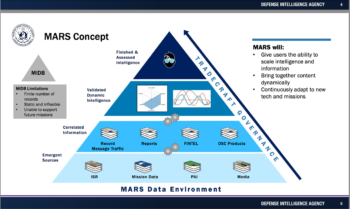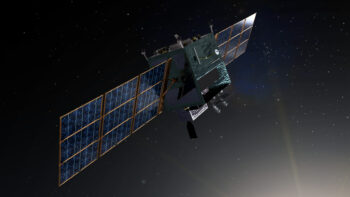
Lt. Gen. Scott Berrier, director of the Defense Intelligence Agency.(Navy photo by Mass Communication Specialist 2nd Class Chris Gaines.)
WASHINGTON — The Defense Intelligence Agency’s ambitious effort to develop a massive, cloud-based database to ingest all-source intelligence — as well as bots to analyze and make sense of that data — is expected to come online as of this coming spring, according to the agency’s director.
The Machine-Assisted Analytic Rapid-Repository System (MARS) will reach initial operational capability in the spring of 2024, and will hit full operational capability in 2025, Lt. Gen. Scott Berrier told the Center for Strategic and International Security (CSIS) today.
“MARS is an evolution,” he said.
DIA’s website explains that MARS “will transform the existing system housing foundational military intelligence into a dynamic, cloud-based system that pairs humans with machines to automate routine processes and enable the artificial intelligence and machine learning needed to make sense of big data and create analytic bandwidth.”
MARS is replacing the 1980s-era database, called the Military Intelligence Integrated Database (MIDB), used by DIA for its primary mission of providing foundational military intelligence to warfighters and national security decision-makers.
“If you were to look at an MIDB record, you might see a satellite photo there with an Excel spreadsheet that describes what that thing is,” Berrier said.
MARS, by contrast, “takes everything that’s in MIDB, but infuses it with the tools that we have available today from all of those sources. And so not only a satellite image and a description, but you will have a map database infused with lots of different open source data points that will tell you what’s going on there — information that we can buy, other information that we can steal. And it gives analysts through alarms and tippers ways to analyze what’s happening and techniques that we haven’t used before,” he elaborated.
 MARS was launched in 2018, using a DevSecOps software approach whereby changes are rolled out on an incremental basis. The agency in August 2020 awarded Northrop Grumman a contract worth $690 million for the Transforming All-Source Analysis with Location-Based Object Services (TALOS), which includes building MARS. (The Northrop Grumman unit that won the contract now is part of Parsons.)
MARS was launched in 2018, using a DevSecOps software approach whereby changes are rolled out on an incremental basis. The agency in August 2020 awarded Northrop Grumman a contract worth $690 million for the Transforming All-Source Analysis with Location-Based Object Services (TALOS), which includes building MARS. (The Northrop Grumman unit that won the contract now is part of Parsons.)
Kari Bingen, director of the CSIS Aerospace Security Project and a former Pentagon intelligence official who worked on MARS, noted that the repository will hold “order of battle objects” such as “facilities infrastructure, military units, [and] records around the world on military activities.”
“It is a phenomenal thing,” she said.
Berrier noted that part of the MARS effort is based on gathering unclassified data so that DIA is able to share analysis with allies and commercial partners.
“It’s critical to them as well,” he said.






















